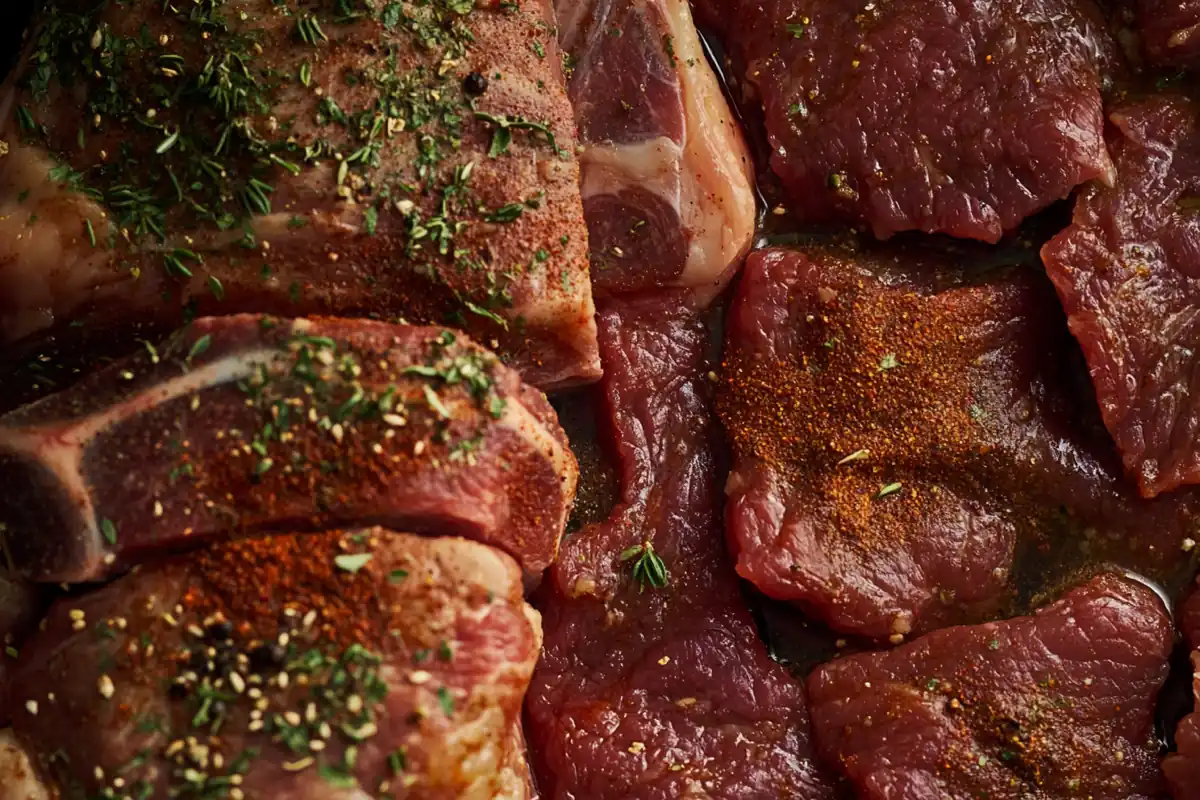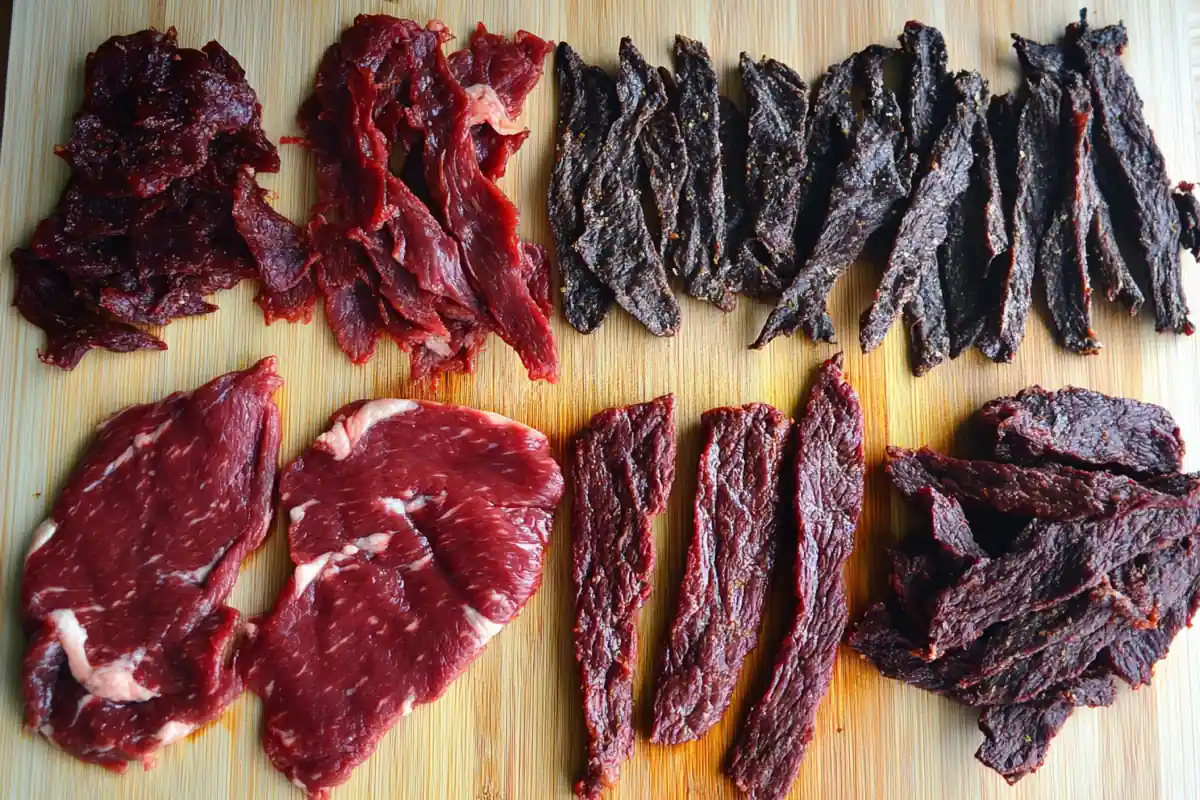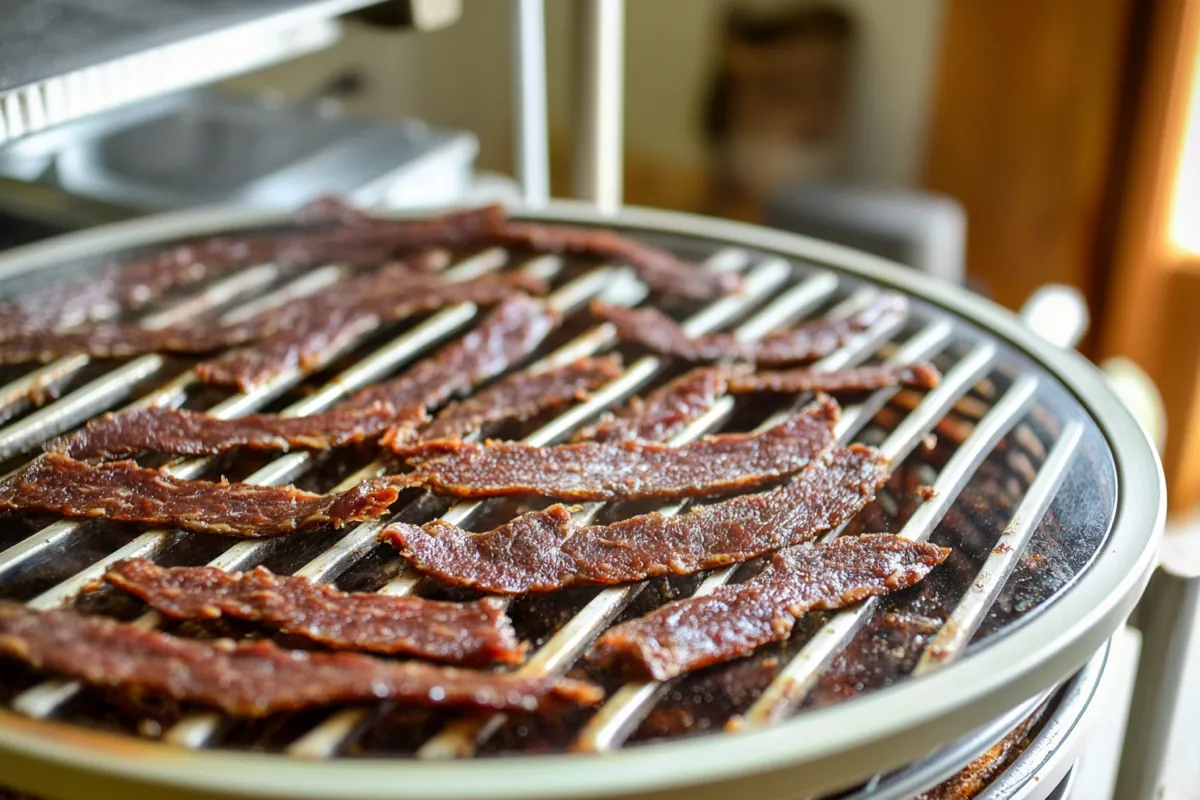Venison jerky is a beloved snack for many, combining rich flavors with a satisfying chew. Whether you’re an experienced hunter or someone who enjoys gourmet snacks, understanding the ins and outs of venison jerky can enhance your culinary adventures. This guide covers everything you need to know, from what venison jerky is to how to make it yourself, ensuring you get the most out of this delicious treat.
Table of Contents
Introduction to Venison Jerky
Venison jerky is dried meat made from deer. This method of preservation dates back centuries, allowing hunters to store meat for long periods. The drying process enhances the flavor and makes the meat lightweight, making it ideal for hiking and camping. Today, it’s not just a survival food; it’s a gourmet snack enjoyed by many.
What is Venison Jerky?
At its core, venison jerky involves marinating and drying deer meat. This creates a chewy, flavorful snack that is high in protein. Many people prefer venison jerky for its unique taste compared to traditional beef jerky. The flavor can vary widely depending on the marinade, ranging from sweet to spicy.
History and Popularity of Venison Jerky
The history of venison jerky is rich and varied. Indigenous peoples used similar techniques to preserve meat long before modern methods were developed. They understood the importance of preserving food for the winter months. Today, venison jerky has gained popularity among outdoor enthusiasts and health-conscious consumers alike.
Cultural Significance
In many cultures, jerky plays an essential role in culinary traditions. For instance, in the United States, hunters often create jerky to share with family and friends, turning it into a social activity. Similarly, in other regions, it’s celebrated for its low-fat, high-protein content, making it a staple for those seeking nutritious snacks.
Modern Trends in Jerky Making
Recently, there’s been a rise in artisanal jerky makers who experiment with unique flavors and ingredients. From teriyaki to peppered varieties, the options are endless. Additionally, the use of high-quality, grass-fed venison has become more common, appealing to health-conscious consumers looking for premium snacks.
Benefits of Venison Jerky
Venison jerky boasts numerous benefits that make it an appealing choice for snacking.
Nutritional Advantages
One of the primary reasons people enjoy venison jerky is its nutritional profile. Venison is typically leaner than beef, containing less fat while providing essential nutrients. It is rich in protein, iron, and B vitamins, making it an excellent option for those wanting to boost their nutrient intake.
Comparison: Venison Jerky vs. Beef Jerky
When comparing venison jerky to beef jerky, several differences arise.
Healthier Options for Snacking
Venison jerky is often lower in calories and fat than its beef counterpart. This makes it a more suitable choice for those who are monitoring their weight or trying to eat healthier. Furthermore, it has a unique taste that can satisfy cravings without the guilt.
High-Protein and Low-Fat Profile
A typical serving of venison jerky can contain around 10-15 grams of protein, while remaining low in fat. This combination makes it an ideal snack for athletes and outdoor enthusiasts who need quick energy and muscle recovery options.

Choosing the Right Cuts for Venison Jerky
Selecting the right cut of venison is crucial for making jerky. The best cuts will ensure tenderness and flavor.
Best Cuts of Meat for Deer Jerky
When it comes to venison jerky, certain cuts work better than others. The most popular choices include:
- Backstrap: Known for its tenderness and flavor.
- Tenderloin: Another tender cut, ideal for jerky.
- Round cuts: These are lean and perfect for drying.

Choosing the Right Cuts for Venison Jerky
Selecting the right cuts of venison is essential for crafting delicious jerky. The quality of the meat greatly influences the final product, so it’s important to know which parts of the deer yield the best results.
Best Cuts of Meat for Deer Jerky
When it comes to making venison jerky, certain cuts are favored for their flavor and texture. Here are the top picks:
- Backstrap: Often regarded as the best cut for jerky, the backstrap is tender and flavorful, providing an excellent base for seasoning.
- Tenderloin: Another highly sought-after cut, the tenderloin is incredibly soft and perfect for jerky, though it can be more expensive.
- Round Cuts: These lean cuts from the hindquarters are also popular. They are less tender than the backstrap but still provide a great jerky experience.
Tender Cuts vs. Lean Cuts
While tender cuts like backstrap and tenderloin are ideal, lean cuts can also be used effectively. Lean cuts generally contain less fat, which is beneficial since fat does not dehydrate well and can lead to spoilage. Therefore, if you’re looking for a longer shelf life for your jerky, consider using leaner cuts for the best results.
Preparing the Meat for Jerky
Once you’ve chosen the right cuts, proper preparation is key to making great venison jerky.
Trimming and Slicing Techniques
Start by trimming any excess fat from the meat. Although some fat can enhance flavor, too much will spoil the jerky. Next, slice the meat into even strips, ideally about 1/4 inch thick. This thickness ensures that the jerky dries evenly and retains the right texture. For a more uniform cut, you can partially freeze the meat before slicing, as this makes it easier to handle.
Importance of Thickness in Slices
The thickness of your slices can significantly affect the drying time and overall texture of the jerky. Thinner slices will dry faster and yield a crunchier product, while thicker slices may take longer to dry and result in a chewier texture. Decide based on your personal preference, but aim for consistency in your slicing for even drying.
Crafting the Perfect Venison Jerky Marinade
The marinade is where the magic happens. A well-crafted venison jerky marinade infuses flavor and enhances the overall taste of the jerky.
Essential Ingredients for Marinade
A great marinade typically includes a combination of acidic, salty, and sweet components. Here are some essential ingredients to consider:
- Soy Sauce: Provides saltiness and depth of flavor.
- Worcestershire Sauce: Adds a savory umami taste.
- Brown Sugar or Honey: Balances the salt with sweetness.
- Spices and Herbs: Garlic powder, onion powder, black pepper, and red pepper flakes can all enhance the flavor.
Common Marinade Bases: Soy Sauce, Worcestershire, and More
Soy sauce and Worcestershire sauce are commonly used as bases for venison jerky marinades. They provide the essential salty and savory notes that complement the natural flavor of the venison. You can also experiment with other bases, such as vinegar or citrus juices, to add a unique twist to your jerky.
Adding Flavor: Spices and Herbs
Incorporating spices and herbs into your marinade is vital for creating bold flavors. Consider mixing in:
- Garlic Powder: For a savory touch.
- Onion Powder: Adds sweetness and depth.
- Black Pepper: Provides a mild heat.
- Crushed Red Pepper Flakes: For those who enjoy a spicy kick.
Step-by-Step Venison Jerky Marinade Recipe
Creating your marinade is straightforward. Follow these steps:
- Combine the Ingredients: In a bowl, mix together soy sauce, Worcestershire sauce, brown sugar, and your chosen spices.
- Adjust to Taste: Taste the marinade and adjust seasoning based on your preference. Feel free to add more spices for a bolder flavor.
- Marinate the Meat: Place the sliced venison in a zip-top bag or shallow dish and pour the marinade over it. Ensure all pieces are well-coated.
- Recommended Marinating Time: Let the meat marinate in the refrigerator for at least 6 hours, but overnight is ideal for maximum flavor absorption.

Dehydrating Venison Jerky: Tools and Techniques
Once your venison is marinated, the next step is to dehydrate it. This process removes moisture, which helps preserve the meat and gives jerky its signature texture and flavor.
Choosing a Venison Jerky Dehydrator
When it comes to dehydrating jerky, selecting the right equipment is crucial. There are several options available, each with its own advantages.
Types of Dehydrators: Electric vs. Oven
Electric Dehydrators: These are specifically designed for drying foods. They offer consistent temperatures and airflow, making them ideal for producing high-quality jerky. Many electric models come with adjustable temperature settings, which is essential for ensuring food safety.
Oven Drying: If you don’t have a dehydrator, you can use your home oven. Set it to its lowest temperature, typically around 160°F (70°C). While this method works, it may take longer and requires more monitoring to ensure even drying.
Key Features to Look For
When selecting a dehydrator, consider the following features:
- Adjustable Temperature Control: This allows you to set the appropriate temperature for meat drying.
- Cross-Flow Fan: Ensures even air circulation and faster drying times.
- Capacity: Choose one that can accommodate the amount of jerky you plan to make.
Dehydration Process
Now that you have your equipment ready, it’s time to start dehydrating your venison jerky.
Preparing the Dehydrator
Before placing the meat in the dehydrator, ensure it’s clean and preheated to the desired temperature. If using an oven, place a baking sheet underneath the jerky to catch any drippings.
Optimal Temperature and Time Settings
The ideal temperature for drying jerky is around 160°F (70°C). Dehydration times can vary based on the thickness of your slices, but typically, it takes between 4 to 6 hours. Check the jerky periodically, as you want it to be dry but still slightly pliable.
Storing and Serving Venison Jerky
Once your jerky is fully dehydrated, proper storage is vital to maintain its flavor and texture.
Best Practices for Storing Jerky
To keep your venison jerky fresh, follow these storage tips:
- Cool Down: Allow the jerky to cool completely before packaging to prevent moisture buildup.
- Use Airtight Containers: Store your jerky in vacuum-sealed bags or airtight containers. This helps prevent air from getting in, which can lead to spoilage.
- Refrigeration: If you plan to keep your jerky for an extended period, consider refrigerating it. This will prolong its shelf life significantly.
Vacuum Sealing vs. Airtight Containers
Vacuum sealing is the best option for long-term storage. It removes air, which slows down the degradation of the jerky. If vacuum sealing isn’t an option, ensure that your airtight containers are truly sealed to keep moisture out.
Creative Ways to Serve Venison Jerky
Venison jerky isn’t just a snack; it can also be incorporated into various meals.
Pairing with Snacks
Try pairing jerky with cheese, nuts, or fruits for a balanced snack. This adds texture and flavor and makes for a great snack platter.
Incorporating into Meals
You can also use venison jerky in recipes. Chop it up and add it to soups or salads for an extra protein boost. It’s a fantastic way to elevate your meals with a unique flavor profile.
For more ideas on how to prepare venison and incorporate it into various dishes, check out our guide on cooking venison tenderloin.

Additional Resources and References
For those looking to expand their knowledge, several resources are available to help you master the art of jerky making.
Recommended Books and Websites
- Books: Look for cookbooks focused on game meat or jerky-making for in-depth recipes and techniques.
- Websites: Explore culinary websites dedicated to venison recipes for more inspiration and tips.
Community and Forums for Jerky Enthusiasts
Joining online forums or social media groups can connect you with fellow jerky enthusiasts. Sharing experiences and recipes can enhance your jerky-making journey.
Conclusion: Enjoying Your Homemade Venison Jerky
Making venison jerky is a rewarding experience that combines traditional methods with modern culinary techniques. By selecting the right cuts, crafting a flavorful marinade, and properly dehydrating your jerky, you can create a delicious snack that’s perfect for any occasion.
Recap of Key Points
Throughout this guide, we’ve explored what venison jerky is, its health benefits, the best cuts of meat, and how to effectively prepare and store it. Remember that the key to great jerky lies in high-quality ingredients and proper techniques.
Encouragement to Experiment with Recipes
Don’t be afraid to get creative! Experiment with different marinades and flavors to find your favorite combinations. Whether you prefer sweet, spicy, or savory, there’s a world of possibilities waiting for you in the kitchen.
FAQ
As you dive into the world of venison jerky, it’s natural to have questions. Here are answers to some frequently asked questions to help guide you further.
Does Venison Make Good Jerky?
Absolutely! Venison makes excellent jerky due to its low fat content and rich flavor. The meat’s natural taste pairs well with various marinades, allowing for diverse flavor profiles. Many people prefer venison jerky over beef jerky because of its unique taste and healthier nutritional profile.
What Cuts of Meat Do You Use for Deer Jerky?
The best cuts for deer jerky include backstrap, tenderloin, and round cuts. These cuts are lean and tender, making them ideal for drying. Tender cuts provide a softer texture, while lean cuts offer a longer shelf life due to their low fat content. Always choose high-quality meat for the best results.
Is Deer Jerky Healthier Than Beef Jerky?
In general, deer jerky is considered healthier than beef jerky. Venison is lower in fat and calories while being rich in protein and essential nutrients. This makes venison jerky a great option for those looking for a nutritious snack. However, the healthiness can also depend on the marinade and preparation methods used.
Do You Have to Freeze Deer Meat Before Making Jerky?
Freezing deer meat before making jerky is not a requirement but can be beneficial. Freezing the meat for about 24 hours before slicing can make it firmer and easier to cut into uniform slices. This helps ensure even drying during the jerky-making process.




